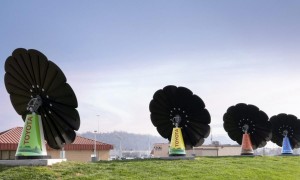From an Article by the Staff of WCHS-TV, February 6, 2023
PUTNAM COUNTY, W.Va. (WCHS-TV) — New power sources that resemble flowers have sprouted up around the Toyota Motor Manufacturing West Virginia plant in Buffalo in Putnam County.
Five SmartFlower solar arrays were recently installed to help power the facility’s services buildings that house the uniform and footwear stores, credit union, clinic and pharmacy, according to a news release from Toyota.
Three EV charging stations also are being powered by the solar arrays, the company said.
Company officials said the solar arrays “bloom” at sunrise and follow the sun’s path throughout the day. With the arrays keeping a 90-degree angle to the sun, the power captured is optimized over traditional solar panels, the company said. The flowers fold back up at sunset.
“This is just one more way Toyota West Virginia is embracing alternative energy and reducing our ecological footprint here in the Mountain State,” David Rosier, Toyota West Virginia’s president, said in the news release.
Toyota said it also has the largest solar array in the state. Located behind the plant, the array can generate 2.6 megawatts – enough to power more than 400 homes. The company said the solar generation reduces the Buffalo plant’s CO2 emissions by an estimated 4 million pounds per year.
#######+++++++#######+++++++#######
See Also: Smartflower Solar Review: Beautiful Solar That’s Not Worth It, Andrew Blok, CNET, May 5, 2022
Our expert, award-winning staff selects the products we cover and rigorously researches and tests our top picks. In the solar panel industry, one company has charted a different path. It’s producing solar electricity, not with rooftop panels or a traditional ground mounted rack, but with solar powered sunflowers.
Smartflower Solar offers what it calls “sculptural” solar: an array of panels that unfurls in the morning, tracks the sun across the sky and folds up at night. It looks like a large, mechanical flower. Smartflower turns solar into a statement as well as a conversation piece and does both with a pretty simple installation process. But while some customers may prefer Smartflower’s look, it comes at a premium. Beautiful design with a high price tag are why most of the company’s customers are organizations, not homeowners.


{ 3 comments… read them below or add one }
Action Alert from Clean Wisconsin, February 16, 2023
Imagine a Wisconsin where coal and methane gas-fired power plants are a thing of the past, and instead, we rely on our own home-grown clean energy!
The High Noon Solar Energy Center, proposed in the towns of Leeds, Lowville, Arlington, and Hampden in Columbia County, is an important step toward that clean energy future.
The Wisconsin Public Service Commission is currently reviewing this project. Your support is needed and can make a difference!
The High Noon Solar Energy Center will:
>> Provide enough energy to power 58,000 homes
>> Cut carbon emissions by more than 16 million tons over its lifetime
>> Generate $1.2 million in in local tax revenue per year
>> Reduce agricultural pollution and soil runoff into local waterways and expand pollinator habitat
Help make this solar project a reality by submitting a written comment to the WI Public Service Commission, and show your support of a clean energy transition in Wisconsin.
To submit a public comment to the Wisconsin Public Service commission click below! All public comments must be made by Friday, March 3rd.
https://apps.psc.wi.gov/ERF/ERF/comment/filecomment.aspx?util=9814&case=CE&num=100&org=825&lvl=100&ite=2373&lea=3133137&ctr=0&par=1&trk=
Daily Question on Current Affairs ~ February 16, 2023
Are the possible rewards of cooling the planet by solar geoengineering, i.e. reflecting solar radiation back to space – worth the risks? (Percentage of 13,278 votes)
No ~ 50.28%
Yes ~ 49.72%
CLOUDS PART FOR SOLAR ENERGY’S PROSPECTS IN WEST VIRGINIA AS WVU AND PARTNERS BUILD A SOLAR-POWER TEST SITE IN FAIRMONT
From WVU Engineering Wired, February 22, 2023
Anurag Srivastava, professor and chair of the Lane Department of Computer Science and Electrical Engineering in the Statler College, will support the construction and analysis of a “solar testbed” at the I-79 Technology Park in Fairmont.
The testbed has been selected for a $2.3 million grant from the U.S. Department of Energy, pending approval and finalization of award negotiations, with land donated by the High Technology Foundation and in collaboration with utility company First Energy.